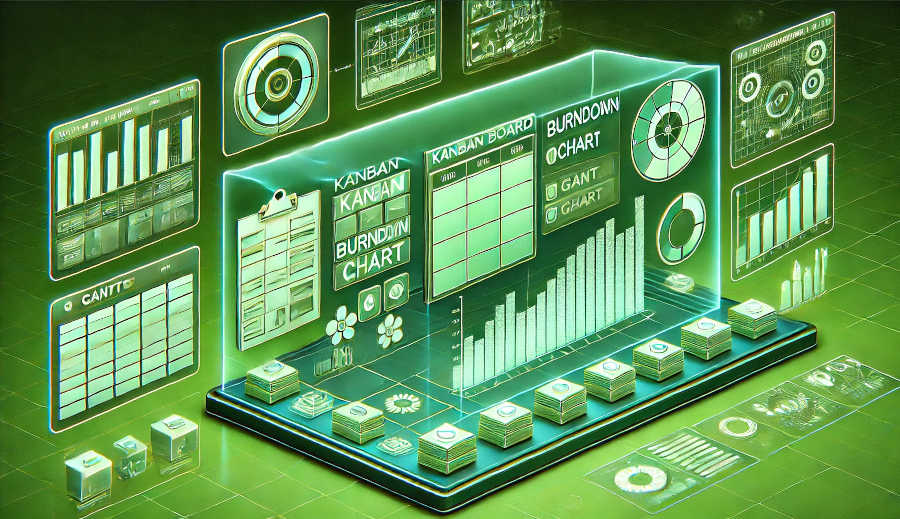In the realm of software development and project management, two distinct approaches have emerged as dominant forces: Agile and traditional development methodologies. At the heart of these approaches are two key roles - the Product Owner in Agile and the Project Manager in traditional development. Understanding the differences and similarities between these two roles is crucial for organizations seeking to optimize their development processes and deliver high-quality products.
The Product Owner in Agile is a role that focuses on maximizing the value of the product. This individual is responsible for defining the product vision, prioritizing features, and ensuring that the development team is working on the most valuable items. On the other hand, the Project Manager in traditional development is more concerned with the project lifecycle, including planning, scheduling, resource allocation, and risk management. While both roles aim to ensure the successful delivery of a product or project, their focus, responsibilities, and working styles vary significantly.
This article will delve into the key aspects of the Product Owner role in Agile and the Project Manager role in traditional development. By exploring their responsibilities, decision-making processes, communication styles, and more, we can gain a comprehensive understanding of how these roles contribute to the overall success of a development effort. This knowledge can then be used by organizations to make informed decisions about which approach and role are best suited for their specific needs.
Responsibilities
The responsibilities of a Product Owner in Agile are centered around the product itself. The Product Owner is the voice of the customer within the development team. They are tasked with understanding the customer's needs, wants, and pain points and translating them into a prioritized product backlog. This backlog is a living document that contains all the features, enhancements, and bug fixes that need to be implemented in the product. The Product Owner is responsible for constantly refining and updating the backlog to ensure that the most valuable items are at the top.
In addition to managing the product backlog, the Product Owner is also responsible for communicating the product vision and roadmap to the development team and other stakeholders. They need to ensure that everyone understands the goals of the product and how their work contributes to achieving those goals. The Product Owner also plays a crucial role in the release planning process. They work with the development team to determine which features will be included in each release and when the releases will occur.
The Project Manager in traditional development, on the other hand, has a broader set of responsibilities that encompass the entire project lifecycle. They start by defining the project scope, objectives, and deliverables. This involves working with stakeholders to understand their requirements and translating them into a detailed project plan. The Project Manager is then responsible for creating a project schedule, allocating resources, and managing the budget.
Throughout the project, the Project Manager monitors the progress, tracks the status of tasks, and ensures that the project is on track. They are also responsible for managing risks and issues that may arise during the project. If any problems occur, the Project Manager needs to take corrective action to ensure that the project stays on schedule and within budget. Finally, the Project Manager is responsible for closing the project, including delivering the final product, conducting a project review, and archiving project documents.
Decision-Making
In Agile, the Product Owner has the ultimate authority when it comes to making decisions about the product. They are responsible for prioritizing the product backlog, which means deciding which features and enhancements are most important and should be worked on first. This decision-making process is based on a variety of factors, including customer feedback, market trends, and business goals. The Product Owner needs to balance the needs of the customer with the capabilities and resources of the development team.
The Product Owner also makes decisions about the product roadmap. They determine the long-term direction of the product and which features and releases are necessary to achieve the product vision. These decisions are often made in collaboration with other stakeholders, such as the development team, marketing team, and senior management. However, the Product Owner has the final say when it comes to making decisions about the product.
In traditional development, decision-making is a more hierarchical process. The Project Manager is responsible for making decisions about the project plan, schedule, and resources. These decisions are often based on the requirements and constraints defined at the beginning of the project. The Project Manager may consult with stakeholders, such as the client, team members, and subject matter experts, but they ultimately have the authority to make decisions.
When it comes to changes in the project scope or requirements, the Project Manager needs to follow a formal change management process. This involves evaluating the impact of the change on the project schedule, budget, and resources, and obtaining approval from the appropriate stakeholders. In some cases, the Project Manager may need to escalate the decision to senior management or a change control board.
Communication Styles
The communication style of a Product Owner in Agile is collaborative and iterative. They work closely with the development team, stakeholders, and customers on a daily basis. The Product Owner participates in team meetings, such as stand-ups, sprint planning, and retrospectives, to keep everyone informed about the product backlog, progress, and any changes. They also encourage open communication and feedback from the team, which helps to ensure that everyone is working towards the same goals.
In addition to internal communication, the Product Owner also needs to communicate effectively with external stakeholders, such as customers and partners. They need to be able to clearly articulate the product vision, features, and benefits to these stakeholders. The Product Owner may also need to gather feedback from customers and incorporate it into the product backlog. This requires strong communication skills and the ability to build relationships with stakeholders.

The communication style of a Project Manager in traditional development is more formal and structured. They typically communicate with stakeholders through regular project status reports, meetings, and emails. The Project Manager needs to provide clear and concise information about the project progress, schedule, budget, and any issues or risks. They also need to manage expectations and ensure that stakeholders are informed about any changes or delays in the project.
In traditional development, communication often follows a chain of command. The Project Manager may need to communicate with senior management, clients, and other stakeholders at different levels of the organization. This requires the ability to adapt the communication style to the audience and ensure that the message is understood. The Project Manager also needs to be able to manage conflicts and resolve issues through effective communication.
Team Interaction
The Product Owner in Agile works closely with the development team to ensure the successful delivery of the product. They are an integral part of the team and participate in all aspects of the development process. The Product Owner provides the team with clear requirements and priorities, and they are available to answer questions and provide guidance throughout the development cycle.
The relationship between the Product Owner and the development team is based on trust and collaboration. The Product Owner needs to trust the team's expertise and allow them the autonomy to make decisions about how to implement the features. At the same time, the development team needs to trust the Product Owner's judgment when it comes to prioritizing the backlog and making decisions about the product.
The Project Manager in traditional development also works with a team, but the nature of the relationship is different. The Project Manager is responsible for managing the team, which includes assigning tasks, monitoring progress, and providing feedback. They need to ensure that the team has the necessary resources and support to complete the project.
In traditional development, the team may be more hierarchical, with the Project Manager at the top. The Project Manager may need to manage different types of team members, such as developers, testers, and designers. They need to ensure that everyone is working together effectively and that there are no conflicts or issues within the team.
Adaptability to Change
One of the key strengths of Agile is its ability to adapt to change. The Product Owner in Agile is responsible for embracing change and incorporating it into the product backlog. They need to be able to quickly respond to new customer needs, market trends, or business requirements. The Product Owner can reprioritize the backlog at any time to ensure that the development team is working on the most valuable items.
In Agile, change is seen as an opportunity to improve the product. The Product Owner works with the development team to understand the impact of the change and how it can be implemented in the shortest possible time. They also communicate the change to the stakeholders and manage their expectations.
In traditional development, change management is a more formal process. The Project Manager needs to follow a set of procedures to evaluate the impact of the change on the project schedule, budget, and resources. They need to obtain approval from the appropriate stakeholders before implementing the change. This process can be time-consuming and may not be as flexible as the Agile approach.
However, traditional development can also adapt to change, but it may require more planning and coordination. The Project Manager needs to ensure that the change is properly integrated into the project plan and that all team members are aware of the changes.
Conclusion
In conclusion, the Product Owner role in Agile and the Project Manager role in traditional development have distinct characteristics and responsibilities. The Product Owner focuses on maximizing the value of the product, working closely with the development team and stakeholders in a collaborative and iterative manner. They are highly adaptable to change and have the authority to make decisions about the product.
On the other hand, the Project Manager in traditional development is responsible for managing the entire project lifecycle, from planning to closing. They have a more formal and structured communication style and work in a more hierarchical team environment. While they can also adapt to change, the process is more formal and may require more planning.
Both roles are essential for the successful delivery of a product or project. The choice between Agile and traditional development, and the corresponding roles of Product Owner and Project Manager, depends on various factors, such as the nature of the project, the organization's culture, and the requirements of the stakeholders. By understanding the differences and similarities between these two roles, organizations can make informed decisions and choose the approach that best suits their needs. This will ultimately lead to more efficient development processes, higher-quality products, and greater customer satisfaction.
ARTICLE TITLE :Product owner role in Agile vs. project manager in traditional development ,AUTHOR :ITpmlib

















